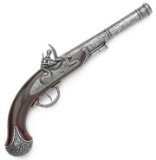Pirate Weapons: Pirate Swords, Pirate Guns, Pirate Cutlass

Pirate weapons could be very destructive, but they might not have been used the way you imagine. Modern weapons are used to destroy the enemy and their ships, planes, tanks, and etc. from great distances, if possible, but pirates in history used their weapons with a much different goal. They were focused on capturing the enemy's ship, contents, and people with as little damage as necessary to the attackers or the prizes. This would make the up-close-and-personal tactic more necessary at times. Read on to discover more about pirate weapons, including pirate guns, pirate swords, and pirate cannons.
>>>In this article about pirate weapons: Long-range / Medium-range / Close-range / Other Weapons
Pirate Weapons and Distance
The type of pirate weapons used depended on when or if the surrender came:
!-Negotiations could happen quickly after a cannon's warning shot or a precise hit to break the main mast or bowsprit.
!!-It could involve getting a little closer and ruining sails, lobbing grenades, or picking off a few with muskets.
!!!-The bloodiest conflicts were the last-resort, close-contact, melees that came during and after boarding, when hell was unleashed with all sorts of items.
Medium- to Long-range Pirate Weapons
Reputation: the number one choice among pirate weapons to inspire fear, intimidation, and hopefully, surrender! A fierce reputation was a weapon without boundaries. Flying on the winds of conversation among captains and crews, merchants and mariners, it could circle the globe and practically force people to decide in advance to surrender, if ever they would meet up with anyone resembling its description.
Pirate flags were one of the best advertisements for reputation.
Cannons and Artillery: Cannons  required four or more men apiece to load, aim, fire, and reposition. By 1700, many improvements for loading, aiming, accuracy, range and speed helped make these pirate weapons more formidable, and its blast of an iron ball 700-1000 yards still turned wooden ship parts into deadly splinter missiles and took down masts with rigging.
required four or more men apiece to load, aim, fire, and reposition. By 1700, many improvements for loading, aiming, accuracy, range and speed helped make these pirate weapons more formidable, and its blast of an iron ball 700-1000 yards still turned wooden ship parts into deadly splinter missiles and took down masts with rigging.
Several types of shot for 50-500 yards were mainly meant to disable the ship somehow:
 Bombs- hollow iron balls filled with powder and topped with a fuse. The goal was explosion on impact, which was timed by the length of the fuse and when it was lit... an exact science, I'm sure. It could almost achieve the same distance as a standard cannonball, but when it arrived, it made a much prettier sound.
Bombs- hollow iron balls filled with powder and topped with a fuse. The goal was explosion on impact, which was timed by the length of the fuse and when it was lit... an exact science, I'm sure. It could almost achieve the same distance as a standard cannonball, but when it arrived, it made a much prettier sound.- Bar Shot- big iron bars that would make large holes as it passed through any part of the ship. The lack of a predictable trajectory would dictate a much shorter range than a bomb or whatever.
- Chain or Knipple Shot-
 pairs of small iron balls joined with chain or a small bar that would rotate through the air and mince any sails and rigging that they tangled with, but did little damage to decks or hulls- a good medium-range choice.
pairs of small iron balls joined with chain or a small bar that would rotate through the air and mince any sails and rigging that they tangled with, but did little damage to decks or hulls- a good medium-range choice.
Medium- to Close-range Pirate Weapons
Stinkpots were small clay pots usually filled with burning sulfur (and sometimes plant gums and rotten fish!) that were thrown onto the deck. A crude form of tear gas, it was hoped the smoke and fumes would overwhelm the victims' desire to fight (or maybe they would vomit themselves into submission).
Hand grenadoes or grenades were named  for the Spanish word for pomegranate, which they resembled. They could be small glass bottles or little pots made of clay, wood, or iron that were filled with black powder mixed with broken glass or scraps of iron and lit with a fuse. Good for shrapnel wounds and shock value.
for the Spanish word for pomegranate, which they resembled. They could be small glass bottles or little pots made of clay, wood, or iron that were filled with black powder mixed with broken glass or scraps of iron and lit with a fuse. Good for shrapnel wounds and shock value.
- Bundle Shot - packs of short metal bars to make short work of a crew or passengers...hurts as bad as you think.
 Grape shot - bunches of little cast iron balls wrapped in canvas or burlap that would make bunches of folks look like Swiss cheese at close range. Grape was often used with a boarding party or to resist one.
Grape shot - bunches of little cast iron balls wrapped in canvas or burlap that would make bunches of folks look like Swiss cheese at close range. Grape was often used with a boarding party or to resist one.- Canister or Case Shot
 - a box or cage or canister filled up with grape, bundle shot, or stones to get the fight over with.
- a box or cage or canister filled up with grape, bundle shot, or stones to get the fight over with.
Just anything- scrap iron, nails, spikes, and yes, when everything else is gone...gold coins! Can you imagine how many of the enemy were trying to catch this shot out of mid-air? Surgeons were said to have cut the coins out of the corpses! Definitely the most expensive of pirate weapons ever....
 Swivel Guns - These portable pirate weapons were like large rifles or small cannon that could be set in place in their sockets on the rail at whatever point the attackers were attempting to board. A blast of small cannonballs could certainly eliminate most or all of the first wave of intruders.
Swivel Guns - These portable pirate weapons were like large rifles or small cannon that could be set in place in their sockets on the rail at whatever point the attackers were attempting to board. A blast of small cannonballs could certainly eliminate most or all of the first wave of intruders.- Muskets-
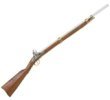
The musket was valued for having more long-distance capacity than the blunderbuss or musketoon - something the Buccaneers valued when attacking the Spanish. Later versions (1800's) with rifled barrels proved a bit more tricky to load. Its longer barrel and single-shot capacity were of no great disadvantage while on land raids; at sea they were used in the early point of a boarding attempt and more often to pick off helmsmen and officers. It was no doubt a great challenge to have good marksmanship when both ships (and the target) were bobbing up and down with the waves.
- The Blunderbuss -
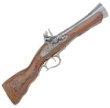
This muzzle loading 'thunder gun' was like a large shotgun with the firepower of a one-person cannon. The bore of around two inches fanned out to a goofy funnel shape at the end of the barrel, thought to help disperse the small pellets over a larger area. About half the length of a musket with a kick like a mule, this gun was literally fired from the hip or another part of the body that could handle the recoil. Its two principal uses were for boarding parties and personal defense.
- The Musketoon...
 was very similar in operation to the blunderbuss mentioned earlier. It was much shorter than the musket but shared the same barrel shape- another close-range equalizer for boarding and general purpose tail-whooping.
was very similar in operation to the blunderbuss mentioned earlier. It was much shorter than the musket but shared the same barrel shape- another close-range equalizer for boarding and general purpose tail-whooping. 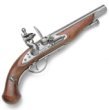
A Flintlock Pistol was highly valued because of its size and maneuverability: a capable pirate weapon in boarding, close-quarters, and disputes in the tavern. A muzzle loading single shot gun was still time-consuming to use, but after firing, the butt end was good for pistol whipping. Flintlocks were often discarded when the fighting got brisk, when the main pirate weapon became the cutlass.
- Multi-barreled pistols
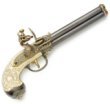
used varying arrangements of locks and triggers to fire the fixed or rotating barrels. These odd pirate weapons were in demand in spite of being bulky, costly to make, and often unpredictable in use.
- Pocket Pistols
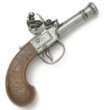
- These forerunners of the Derringer were tiny muzzle loaded guns of convenience that were placed where they could be retrieved quickly and easily for a last-minute gut or face shot. They are the grandfather of what did in President Abraham Lincoln (besides the stupid doctors poking around in his brain with long probes).
- Volley Guns
 - Whether in pistol or rifle form, these pirate weapons would fire their several barrels at once, forming a kind of dotted line that you were daring any boarders to cross. Remember, there ain't no breech loading of these things, so the operator would need to ask for a time-out in the battle just to reload.
- Whether in pistol or rifle form, these pirate weapons would fire their several barrels at once, forming a kind of dotted line that you were daring any boarders to cross. Remember, there ain't no breech loading of these things, so the operator would need to ask for a time-out in the battle just to reload.
Close-range Pirate Weapons: cutlasses, knives, etc.-
The Cutlass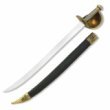
is
the weapon most associated with the pirates and was probably more common
among them at times than even a flintlock pistol. Here is the one thing
that would keep working after all the guns were discharged; a pistol took
precious time for a reload, but another slash wound was just an arm swing
away. With cutlasses being shorter than swords or sabers and having a broader,
sturdier, curved blade, they were ideal for fighting in the close confines
on or below deck.
They were believed to have evolved from the 'Boucan' hunting knife of the French Buccaneers, and the blades needed to be sturdy for the other tasks on the ship like cutting down doors, cutting lines, and dividing pieces of eight. Their handles offered some cushioning with leather wrapped on the bone or ivory stock. (There was also a straight type of cutlass called a shortsword or a stabbing dagger.)
Daggers and Dirks, the smaller knives--
The Dagger was a small multipurpose knife that was used at supper and slaughter as well. With a straight blade, it was for thrust and puncture, not slash and gash like the cutlass.
It is notable that the dagger always had a cross bar or hilt to keep the hand off the blade and swords off the hand. The hilt's most important function came into play during a cutlass fight, because it could 'catch' the strike of the blade. The user could deflect the blow, swiftly swing the cutlass to the side, and answer with a hard cutting motion of his own. A Dirk was a particular type of small knife that was designed and used mostly for throwing. It is often depicted as being smaller than a dagger (compare to the Bowie knife or stiletto).
- Scabbards-
 Many pirates being ex-navy men of one degree or another, they brought with them much of the training and expertise of their former occupation. Having clean weapons was ingrained in the pirate of average mettle, and scabbards for your knives was a must.
Many pirates being ex-navy men of one degree or another, they brought with them much of the training and expertise of their former occupation. Having clean weapons was ingrained in the pirate of average mettle, and scabbards for your knives was a must.
Boarding Hooks were used with lines to pull ships closer, which were then lashed together for the boarding.
used with lines to pull ships closer, which were then lashed together for the boarding.
Other Pirate Weapons-
Boarding Axes, with a two or three-foot handle and a combination of sharp blade and blunt hammer side, were used to cut the ropes of boarding hooks, bring downs masts and rigging, and generally tear through anything like doors, hatches or locks. Even though they were a useful tool, their size and shape did not make them a very good pirate weapon (but someone would always prove to be the innovator).
The Marlinespike (or 'hand fid' if wood) held the Most Favored Pirate Weapon status among those with mutiny on their mind. These nifty picks made of steel, wood, or bone were essential in the various jobs involving ropes and lines, but somebody with crabs in their breeches would inevitably grab one and try to be mean about who's in charge, when do we get paid, and such.

